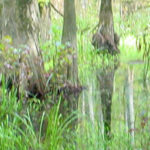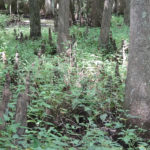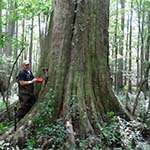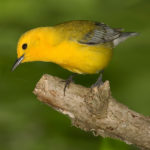Bottomland Forests
Bottomland forests are found in areas where water is above or near the ground surface for extended periods of time. The North Carolina Forest Service estimates that bottomland forests comprise about 13% of North Carolina’s 18.8 million acres of forests. While they cover a relatively small amount of area in the state, these forests play an important role in protecting water quality, storing flood water and providing habitat to a wide variety of wildlife species, recreational opportunities and forest products.
 |
GENERAL INFORMATIONNot all bottomland forests are the same. Differences in hydrology, terrain, soils and position on the landscape create different forests. Common North Carolina bottomland forest types are black, red and deep swamp; slough; piedmont bottomland; pocosin; and carolina bay. Common characteristics and specific differences are discussed in these articles. |
 |
MANAGEMENTTrees in bottomland forests tend to grow slowly, so management is usually more passive and over a longer time period than management in pine or upland hardwood forests. Review articles about the many aspects of bottomland forest management here. |
 |
TREESNorth Carolina’s bottomland and swamp forests are home to a diversity of trees that are able to tolerate standing water. Species that are commonly found in North Carolina’s bottomland forests are discussed here. |
 |
WILDLIFEBottomland forests provide important habitat for many birds, mammals, reptiles and amphibians. Learn about the common wildlife species found in bottomland forests in this section. |
